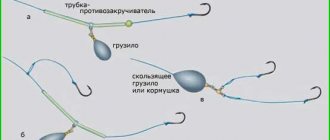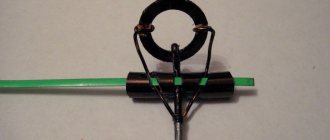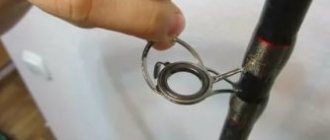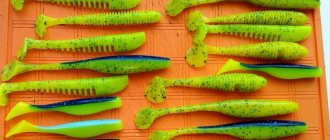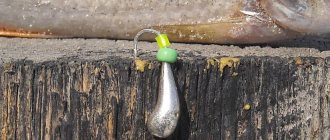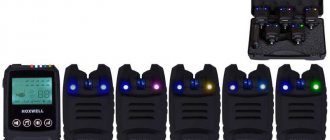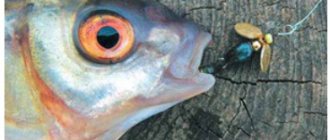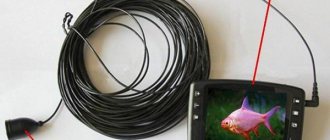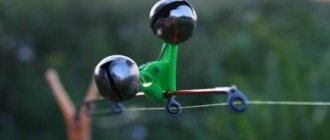Basically, classic winter gear sets are used for fishing with a jig or spinner. But some avid fishermen, who are constantly searching, modify their gear, which makes fishing more productive. Of particular interest is the option of a self-hooking fishing rod for winter fishing, which is not at all difficult to make yourself.
A self-hooking winter fishing rod is interesting because it allows you not to miss the moment of a fish bite. This factor has a positive effect on successful fishing.
Operating principle and design of the self-cutter
This design consists of the following elements:
- Handles.
- Rubber bands.
- The groove where the trigger mechanism is located.
- Loops where the nylon thread is attached.
- Nylon thread.
- Steel spring.
- Loops where the trigger mechanism is mounted and the fishing line is inserted from the reel to the nod.
- Six.
- Trigger.
- Telescopic nod.
- Nod bases.
- Fishing line (monofilament).
- Folding legs.
- Inertial reel with brake.
- Groove for spring.
- Trigger rod.
When a bite occurs, the fishing line connected to the trigger mechanism moves forward. Then, the trigger mechanism moves from the stop as a result of the action of the spring, after which an instant throw back occurs, which entails the fishing line.
When a fish takes the bait and carries it along with it, the spring stretches to a certain point, which creates some resistance to the movement of the fish. After this, there is an abrupt stop, and the hook catches on her lip. This is the so-called self-hooking of fish. After this, you can start pulling out the fish, although it will not escape from the hook. In winter, such a device is more useful than ever.
When using monofilament fishing line, which is not afraid of even severe frosts, the device shows excellent results in catching fish. Self-cutting tackle will always provide the fisherman with a catch.
Purpose of self-cutters
A self-hooking device is a device designed to perform hooking at a certain tension force on the fishing line or cord when a fish bites. Self-cutters are used in the following cases:
- With a large amount of gear. If an angler fishes with 4-5 feeders, then he will not be able to equally monitor each tackle. In this case, he will be helped by self-cutters who will perform the sweeps for him;
- When fishing at night. At night, automatic hookers will give you the opportunity to sleep for a couple of hours and not worry that the bite will be missed;
- With a weak bite. When the fish is inactive, it is easier for the fisherman to install all the gear in the self-hooking hooks, adjust them for a weak bite and fish at this time with a float rod;
Do not use self-hookers when the bite is active - in this case, the fisherman will spend a lot of time reloading the very quickly triggered self-hookers. In this case, it will be easier to hook manually and fish with no more than 3 feeders.
Types of self-undercutter
Our time is characterized by the presence of a wide variety of similar designs. The most interesting developments are:
- A self-cutter designed according to the “mousetrap” principle. As soon as the fish grabs the bait and pulls on the line, the trigger mechanism is immediately activated. The spring pulls the lever, and the line is instantly fixed, due to which the fish is hooked. The entire mechanism needs to fit on a small piece of plywood. In case of a large specimen being bitten, a special pin is provided to hold the mechanism at the installation point.
- The hooking mechanism is based on a special lever. This design has both advantages and disadvantages. The principle of operation is that the tension of the fishing line releases the lever, which, under the action of a spring, sharply pulls the fishing line, due to which the fish is hooked. The design is such that you can adjust the amplitude of the hook, depending on the nature of the bites.
- The undercutter is based on a lever, but the power element is not a spring, but an aviation elastic band consisting of 4 or 8 threads. When the fish bites, the mechanism with the tensioned rubber band is released. Its strength is enough for the hook to penetrate the lip of the fish. This mechanism is simple and reliable.
Option 1
The self-hook is designed for use with a fishing rod or spinning rod and the spring properties of the rod. During a bite, the bent rod is released by the hooking mechanism, as a result, the fish is automatically hooked without any action from the fisherman.
In the image we can see a general diagram of the operating principle of such a system.
To connect the parts of the self-undercutter structure, wire bushings are used, which are soldered, or bolts - you can choose one of these solutions.
There are different options for the material - steel with or without galvanization, preferably brass. In general, whatever is at hand.
Tips for a fisherman: How to make a fishing rod for winter fishing - Detailed review
All the elements of the homemade product need to be connected and at the same time ensure that the moving parts should move easily and not get stuck anywhere. You can put a minimum amount of machine oil on them.
Now we have one part of a homemade auto hook. You can make a holder for installing a fishing rod or spinning rod with your own hands or buy a ready-made glass. Or take some other object of a suitable shape to attach the rod to. For example, you can use the diagram below.
The autocutter is ready. You can put the homemade hooking mechanism in the working position and wait for the fish to be hooked.
How to make a self-hooking fishing rod with your own hands
Such tackle can provide significant assistance to the fisherman when fishing from ice. The fishing rod will be able to catch fish itself, and the fisherman at this time can only watch and mind his own business. For example, drill other holes and install the same gear. If the fish bites, it will be caught automatically.
To make a fishing rod, you need to have the following materials and tools:
- Metal scissors.
- Pliers.
- Electric drill.
- Sheet metal (any).
- Steel wire, 0.2 mm thick.
- Screws and screws.
Manufacturing technology
Winter self-cutter
- At the initial stage, a metal plate is prepared. 1.1. A blank measuring 130x80 mm is cut out of a pre-prepared piece of sheet metal. The plate will serve as the base of the structure. 1.2. All points for drilling and marks for bending should be marked on the plate. 1.2.1. From the smaller side (80 mm) you need to retreat 30 mm and draw a straight line extending 35 mm from the sides. 1.2.2. After this, you need to retreat another 20 mm and draw a line 10 mm long. 1.2.3. A mark is made near each corner for a mounting hole. 1.3. Using metal scissors, all excess is cut off, and holes are made using an electric drill. 1.4. After the cutting process, the edges are clamped and a semi-oval with holes is formed. 1.5. The remaining sheet, measuring 130x20 mm, is folded in half. The result will be a part 130 mm long and 10 mm wide. 1.6. Closer to the end of the resulting workpiece, holes are drilled at a distance of 45 mm from each edge.
- A wire is taken and a loop is formed at one end, and the other end is bent at an angle of 90 degrees. 2.1. Measuring 30 mm from the curved end, you need to form another loop. This type of equipment can be adjusted depending on the size of the base.
- If everything is prepared, then you can begin assembling the structure. 3.1. The first workpiece is connected to the wire using nuts and bolts. At the tip of the spring you need to form a small hook, with the help of which the clutch will engage the lever. 3.2.1. The lever is attached to the base in a similar way. 3.2.2. The bolt is inserted into two holes so that the spring and lever are secured. The lever must be attached to the spring in order to be stationary. 3.2.3. The fishing rod is ready for use.
Features of different types of undercutters
The most important characteristic in the operation of any automatic hooker is undoubtedly the force with which it affects the prey. In accordance with the required impact force, the tension power of the springs or rubber used in the device is calculated.
As a rule, it is more significant the heavier the gear for which the mechanism is intended. For example, a feeder hook requires more actuation force than a hook hook with a short stick or no stick at all.
Tips for a fisherman: How to assemble a winter fishing rod with a float - All the nuances
Attention! As a rule, over time, springs stretch and lose some of their power. This must be taken into account when setting up the self-cutting mechanism.
It is also important to consider the force required to remove the device from the safety stop and initiate the actual strike. Stoppers and triggers, depending on the gear, also come in different designs and power, but what is essential is that they all must be sensitive enough, this will ensure that the device responds to any, even the most careful bite.
It should be taken into account that an industrially manufactured fishing hook is designed for a specific gear, with specific requirements, only if it comes complete with this gear. The remaining industrial mechanisms, which have different principles of operation and power, must be selected for your equipment independently and, if necessary, modified.
A do-it-yourself hooker always takes into account the characteristics of the rod, the tackle for which it was conceived and made. For example, a do-it-yourself auto-hook for spinning rods must take into account the following factors:
- Weight and length of the spinning rod.
- Approximate distance for casting baits. This is important for approximate calculation of the mass of equipment in the water.
- When trolling - the strength of the current and the speed of the boat.
- The size of the expected trophies, their type, as well as how the bite of this type of fish usually occurs (carefully or quickly).
If a fisherman who independently manufactures an automatic hooker for his equipment manages to take into account all these factors and makes a suitable device, the number of unnoticed or empty bites will be significantly reduced.
When making hooks intended for bottom gear, fishermen often use a variety of runners in combination with rubber bands or converted mousetraps. Also common are vertical posts that are fixed in the ground or at the side of the boat, with powerful springs and appropriate stoppers.
Standing apart from all the devices for automatically hooking fish are floats and hooks.
A float that promotes self-hooking of fish is, as a rule, a regular float with an elongated central rod, complemented by a disk of non-sinking material with a hole in the center for the passage of the upper part of the float rod and a special stopper (thickening) in the upper part of this rod.
When biting, the main part of the float’s body goes under the water, but at the end the stopper interacts with the disk, which sharply slows down its descent under the water and promotes the fish’s self-hooking.
Of the large list of self-hooking fishing rods, the most popular in terms of demand and purchase are:
Self-cutting fishing rod: where to buy
Self-cutting fishing rod for winter fishing Novy Oskol
Currently this is not a problem. It is enough to visit a well-known fishing store or use an online store. In any case, it is possible to obtain comprehensive information about the availability of various design solutions. Financial capabilities, as well as personal preferences, play an important role. And, nevertheless, this simple device will very quickly pay for itself, no matter how much it costs.
Review of the best models
- Bottom tackle called “Whip”, which uses the principle of self-cutting, is distinguished by the rather soft action of the device itself. A smooth increase in resistance is ensured by the process of turning the guard around the nail. The predator, at the moment of the bite, behaves quite warily. The smooth operation of the mechanism ensures precisely that moment when the predator has not yet realized that he is already on the hook.
- The design of a fishing inertial reel with a self-cutting mechanism. This design has increased functional data, which will certainly interest any lover of ice fishing. The bulk of such structures are homemade, the cost of which depends on various factors. You can find models that cost 100 rubles, or you can find them for a thousand rubles. It all depends on the quality of workmanship. There are craftsmen who put their soul into each product, and there are craftsmen who care more about their personal income.
To make a self-cutting fishing rod yourself, desire alone may not be enough. The fact is that this is a design that requires fairly precise tuning. If this is not done, then the fishing rod will not catch fish, which will lead to the appearance of negative emotions. I don’t know how this is done, but it will not be possible to ensure effective fishing. For everything to work out, you need to know a lot, including the behavior of the fish. It is better to have a device that can be configured to catch any type of fish. The fact is that each type of fish grabs the bait in its own way, and applies different force. If you don’t adjust the mechanism properly, you may simply not see bites, or they will be frequent and false.
Automatic undercutter video photo 004
Igor 07/21/2017


